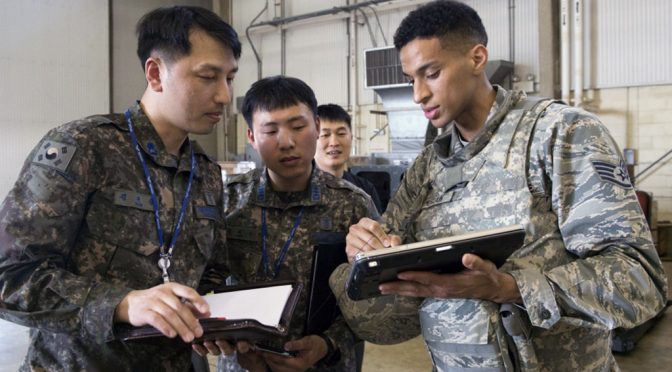By Tim McGeehan and Douglas Wahl
A significant science and technology gap currently exists between the military forces of the United States and those of most of the rest of the world. This gap is by design and has long served as a centerpiece of U.S. defense strategy. While it has allowed the U.S. to maintain military primacy for decades, the technical capabilities of many allies and partners now lag far behind, raising concerns about the gap’s impacts on interoperability. This gap can drive critical tactical and operational decisions on where, when, and how forces are employed in a multinational environment, often with political ramifications. While the science and technology gap must be maintained over adversaries for strategic reasons, just as much effort should go into mitigating it to ensure maximization of allied capability in today’s coalition environment.
Creating the Gap
It is interesting to note that America’s allies helped it get to the top and establish the science and technology gap in the first place. Microwave radar, gyroscopic gun sights, and penicillin were key innovations critical to World War II military success and all of the initial work was performed by European scientists.1 One technology transfer episode stands out in particular when in 1940, a group of British scientists came to Washington, D.C., on what would become known as the “Tizard mission.” In a series of meetings during September and October 1940, the British shared examples and schematics of advanced technology, including rockets, explosives, superchargers, the cavity magnetron (the key to airborne radar), self-sealing gas tanks, advanced sonar, and three pages concerning a project known under its code name TUBE ALLOYS, which was the seed for the Manhattan Project.2 The British provided this giant leap forward in technology because they required America’s technical expertise to further refine these inventions, but more importantly, required the American industrial base to put them into practical use and production. This mutually beneficial exchange helped to later turn the tide of the war in the Allies’ favor.
The U.S. also leveraged German advances in science and technology. OPERATION PAPERCLIP was an effort to collect and extract German scientists before the Soviet Union could capture them in the closing days of World War II. These Germans were experts in aerodynamics, rocketry, and chemistry, and had invented or contributed to several of Hitler‟s “Wonder Weapons,” including the V-2 rocket (ballistic missile), V-1 flying bomb (cruise missile), and jet fighter.3 Many of these scientists had been classified as war criminals, but instead of facing prosecution were protected and put to work by the U.S. government in many programs, including what would become the intercontinental ballistic missile program and National Aeronautics and Space Administration (NASA). The father of the U.S. space program himself, Werner von Braun, was one of these scientists.4
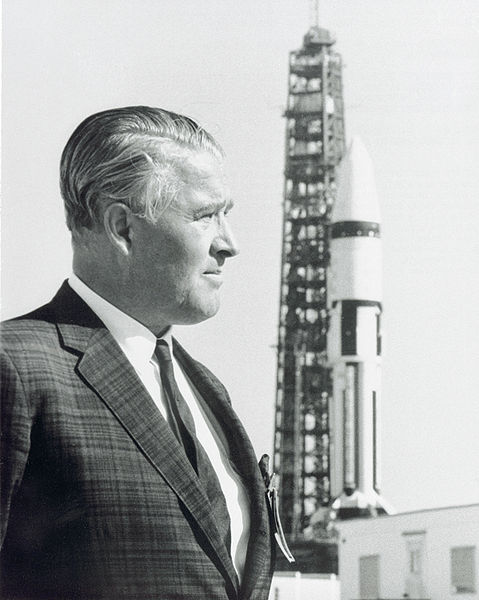
The U.S. military continues to leverage technological contributions from allies and partners, with agreements like the recently established Science and Technology Project Arrangement between the U.S. and the U.K. for energetic materials research and the Statement of Intent between the U.S. and Sweden to conduct cooperative research and development of undersea warfare and air defense technologies.5 Programs like these are the legacy of the Tizard Mission and OPERATION PAPERCLIP that helped propel the U.S. military to forefront of military science and technology, a position that it has sought to maintain ever since.
Offsets: Sustaining the Gap
The atomic bombs that ended World War II in Japan were a clear demonstration of the value and power of scientific superiority. With this lesson in mind, the U.S. engaged in massive national efforts to maintain its scientific edge. In particular, after being shocked by the Soviet launch of Sputnik, the U.S. government passed the National Defense Education Act in 1958.6 At its signing, President Eisenhower said it would “do much to strengthen our American system of education, so that it can meet the broad and increasing demands imposed upon it by considerations of basic national security.”7 Adjusting for inflation to 2017 dollars, the act provided $850 million for student loans for science majors, $2.5 billion for science equipment, and $8.5 billion worth of fellowships for graduate students in science.8 The rationale was that only federal investment in the sciences would allow the nation to achieve the technological superiority over its primary competitor, the Soviet Union.9
This was particularly important because the U.S. could not compete numerically against the conventional forces of the Soviet Union. The Eisenhower administration knew it had to rely on its science and technology advantage, specifically nuclear deterrence, to avoid the costly option of deterring the Soviet Union via a massive increase in conventional capabilities. This was the first “offset strategy” and maintaining the technological lead was absolutely imperative for it to work.
By the 1970s the Soviet Union had closed the gap in nuclear weapons. In 1973, the forerunner of the Defense Advanced Research Projects Agency (DARPA) launched the Long-Range Research and Development Planning Program to seek out a second offset strategy.10 It pursued “conventional weapons with near-zero miss” which resulted in networks, stealth, and high tech precision munitions. Again, the science and technology gap drove the offset. This focus served the U.S. well through the next 30 years, but adversaries are now acquiring increasingly complex technology in pursuit of anti-access and area-denial strategies; the gap is rapidly closing again.
In response, the Department of Defense is currently developing a third offset strategy and innovation is the vehicle to get there.11 The Defense Innovation Initiative, overseen by the Advanced Capabilities Deterrence Panel, is chartered to maintain U.S. military supremacy against any challenger. In November 2014, Secretary Hagel explained “our technology effort will establish a new Long-Range Research and Development Planning Program that will help identify, develop, and field breakthroughs in the most cutting-edge technologies and systems – especially from the fields of robotics, autonomous systems, miniaturization, big data, and advanced manufacturing, including three-dimensional printing.”12 He went on to say “we will not send our troops into a fair fight. A world where our military lacks a decisive edge would be less stable, less secure for both the United States and our allies, and the consequences could ultimately be catastrophic.”13 Note that he said “our military” (U.S.) not “our militaries” (including allies) need the decisive edge.
Impacts of the Gap
Examples throughout history have shown the value of allies and partners, both in peace and in war. Allies and partners bring authority, access, signal international resolve, and enhance the legitimacy of any endeavor. However, the opportunity to reap these benefits is increasingly put in jeopardy as advances in U.S. systems hamper interoperability.
For instance, while the U.S. Navy must maintain its technological lead amongst naval competitors, it cannot afford to operate alone. The Global Network of Navies concept illustrates how valuable allies and partners can be moving forward.14 While not every navy can afford the latest high tech systems, they often bring niche capabilities, experience, and expertise such as icebreaking, counter piracy, littoral operations, etc. One particular example is the Standing North Atlantic Treaty Organization‟s (NATO) Mine Countermeasures Group TWO (SNMCMG2). SNMCMG2 comprises mine hunters, minesweepers, support ships, and explosive ordnance disposal personnel from Belgium, Germany, Greece, Italy, Spain, Turkey, United Kingdom, and the U.S. No one nation can field this level of capability (or capacity) alone. However, this interoperability is more common at the lower-intensity end of the naval warfare spectrum. Fielding systems with the speed and complexity required to win the high intensity engagements of modern war at sea (and any domain for that matter) is costly and creates major challenges to interoperability.
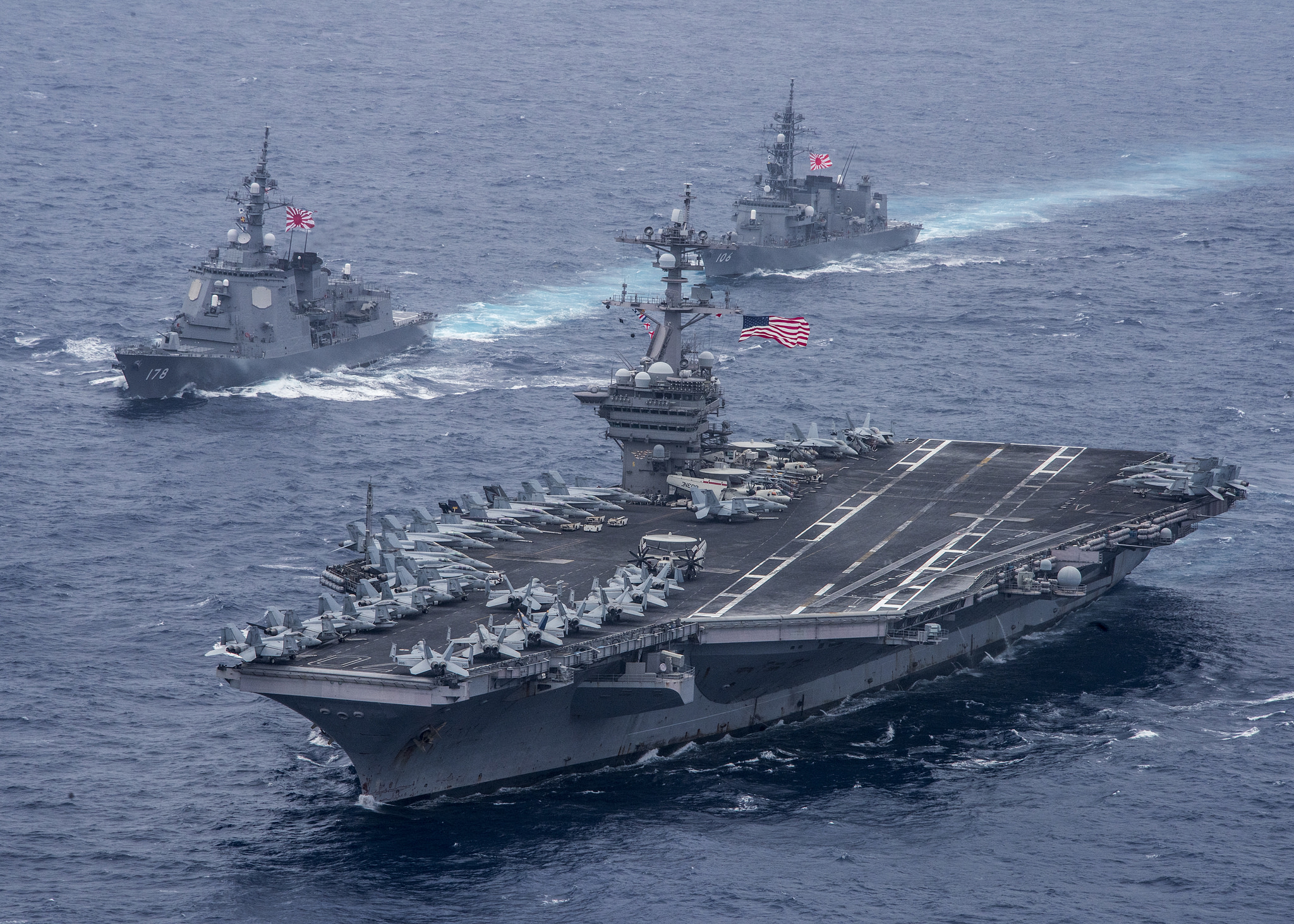
Interoperability between forces takes many forms. Compatible tactics, techniques, and procedures are required for forces to work together and achieving proficiency is largely a function of training. However, there are technology and equipment components of interoperability that are much harder to address. The U.S. military boasts a sustained long-term and large-scale investment program in science and technology, unmatched by any nation. The result is that the U.S. has fielded extremely capable but highly complex and expensive systems that are often far more sophisticated than those of its allies. Many of these systems are not capable of easily interfacing with allied systems (if they can interface at all), placing limitations on the missions that can be shared. Using an Air Force example, the fifth-generation American F-22 Raptor cannot send encrypted messages to fourth-generation fighters such as the British Typhoon or French Rafale. To remain stealthy, it was designed to communicate via encrypted messages with other F-22s and U.S. systems, but has to use traditional voice communications with these allies that nullify its stealth advantage by having to talk ‘in the clear.’15 Procuring the latest and greatest hardware from America‟s defense industry may cause the U.S. military to price itself out of fighting in and with coalitions.
The gap between U.S. and European capabilities had become so glaring that at a 2006 NATO conference a Canadian delegate remarked “NATO’s transatlantic capability gap has been at the heart of a debate over the viability and relevance of the Alliance in the new security environment.”16 To question the Alliance is shortsighted, but the concerns are valid.
Communication and interoperability of data enable the construction, maintenance, and sharing of a common operational picture (COP). This is critical for the commander’s situational awareness and allows them to mass forces and effects as required. However, some high-end systems can only communicate with similar systems or have proprietary data formats unreadable by others. In these cases, sharing the COP with incompatible units can be difficult, time consuming, and prone to errors. A lack of shared awareness adds to the fog and friction of operations, induces vulnerabilities, and in worse cases, leads to fratricide.
Incompatible units operating in close proximity can even be a detriment to mutual safety and efficiency of operations. For example, electromagnetic (EM) spectrum management is far more demanding in multinational operations than in joint operations.17 For the Navy, while operating in a tight Carrier Strike Group (CSG) formation (e.g. during a strait transit), unless explicitly deconflicted, an allied ships radar or communication system might cause EM interference on a U.S. system (or vice versa) with impacts ranging from blinding a radar to deafening a communications system. Likewise, in today’s cyber world not all defenses are created equal, and one nation’s military with lesser capabilities may inadvertently open the door to an adversary intrusion that threatens others, weakening trust.
There are also logistical concerns associated when operating with less capable forces. Highly sophisticated systems often cannot share replacement parts or components and may have unique fuel or power requirements. Additionally, a weapon system may rely on ordnance not found anywhere else in the multinational force. The aggregate effect of these issues necessitates that the U.S. maintains a unique logistical system for the sustainment of its units in the field, the burden of which usually cannot be shared by our allies. There are exceptions, like the recent Acquisition and Cross-Servicing Agreements process whereby a U.S. Navy and Japanese Maritime Self Defense Force destroyer exchanged maintenance parts.18 However, the fact that this transfer (in March 2017) was the first one ever completed illustrates how rare it is.
Another possible impact of operating with less technologically advanced allies or partners is that they may have slower decision cycles, be less lethal, or be less survivable, thus presenting softer targets to capable adversaries. The U.S. may need to provide enhanced force protection or over-watch assets to assist them, lest they be targeted by the adversary at a disproportionate rate. Such a situation could threaten the integrity of the coalition both politically and operationally. If the U.S. assigned additional resources to mitigate this situation, it would do so at the expense of finite resources available to accomplish the mission elsewhere.19 This situation could lead to U.S. attempting to micromanage coalition partners, which would further stress the coalition.20
U.S. joint doctrine states that the composition of multinational task forces “may include elements from a single nation or multiple nations depending on the situation and the interoperability factors of the nations involved.”21 In Desert Storm the coalition utilized a parallel command structure with some forces falling under a U.S. chain of command while the Arab contingent fought under a Saudi chain of command. While this arrangement was primarily adopted for political considerations to avoid the optic of a U.S. dominated effort, it was also due in part to military interoperability concerns.22
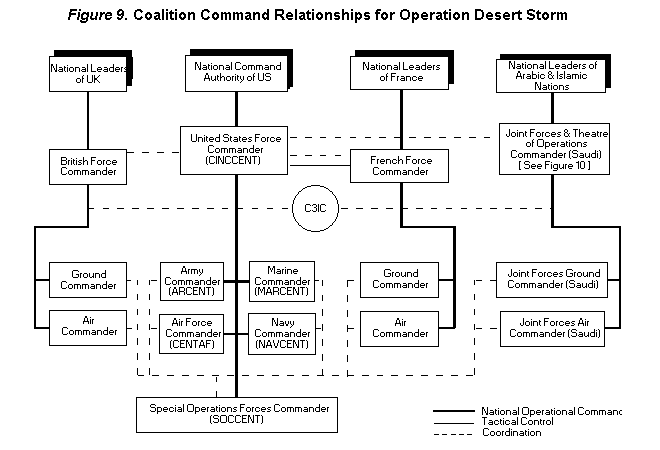
This all begs an important question: if the science and technology gap leads to so many interoperability challenges, why isn’t there more effort to close it? The reality is that there is little incentive to close it.
Lack of Incentive to Close the Gap
A discussion of the incentives to close the science and technology gap between the U.S. and its allies and partners inevitably leads to the bigger question of how to best share the global defense burden. Even though the U.S. has exquisite capabilities doesn’t mean that it can afford to do all of the high-end warfighting alone. However, many other nations do not have the funding, technology, or industrial base to assume more of the burden. More importantly, many of them do not have the political will to do so. Secretary of Defense Carter and more recently Secretary of Defense Mattis both called Europe out for “not doing enough” to ensure their own security in that they have become reliant on the U.S. military to bear a large part of the collective burden.23 In 2002, NATO nations agreed to pay two percent of their gross domestic product on defense, but many nations have not made good on their commitment.24 What incentive do they have to make the substantial investment to develop their own science, technology, and industry to close the technology gap when the U.S. can be counted on to do it for them?
That said, in some ways, the U.S. may not have as much incentive to assist its allies in closing the gap as one would think. Despite the previously mentioned tactical challenges, the uncomfortable truth is that at the strategic level the U.S. has contributed to and in some ways benefited from this arrangement. As long as other countries lag behind U.S. military in science and technology, they will continue to rely on U.S. for the associated forces and hardware. This provides the U.S. influence and leadership capital. For example, the European Phased Adaptive Approach provides European ballistic missile defense (BMD). However, the U.S. has not provided Europe their BMD technology, but has instead secured permission to station four BMD-capable Aegis destroyers in Rota, Spain. The U.S. has also established an Aegis Ashore capability at the U.S. Naval Support Facility in the countryside of Devesulu, Romania.25 The U.S. readily accepts this role as senior partner for smaller countries and in doing so secures basing rights and strategic footholds, builds coalitions, and offsets attempts at hegemony by regional powers like Russia.
Often when the U.S. sells advanced, sophisticated equipment to other nations the agreement comes with U.S. training, support, and logistics which are other avenues for influence. This carries the threat of suspending the deal or making sustainment contingent on some other national behavior. This dynamic recently played out in 2014 when France refused to deliver two new Mistral-class amphibious assault ships to Russia based on its activity in the Ukraine.26 Likewise, the U.S suspended military sales and the delivery of 20 F-16 C/D fighters to Egypt in 2013 due to political unrest27 and the overthrow of their democratically elected president,28 and then again the U.S. suspended military assistance to Thailand following their 2014 military coup.29
The fluidity of today’s strategic environment also dictates that today’s ally could be tomorrow’s adversary. Iran still has F-14 Tomcats, F-4 Phantoms, and P-3 Orions in its inventory from the time when a previous regime enjoyed close relations with the U.S. Sharing sophisticated technology with an ally could be disastrous if they become overrun, captured, or surrender their equipment to an enemy. Luckily the Iraqi army had no game-changing technology to abandon to the Islamic State of Iraq and the Levant (ISIL), but the recent episode is a cautionary tale.
Another reason the U.S. won’t assist its allies in closing the gap is that it wants to prevent proliferation of strategic technologies. Through strategic nuclear deterrence the U.S. extends a guarantee to allies thereby discouraging them from pursuing their own nuclear capabilities and with fewer such weapons in play reducing the likelihood of their use. A notable exception is the joint strategic program with the United Kingdom which is currently developing the Common Missile Compartment for new ballistic missile submarine classes.30

Finally, it is interesting to note that allies could likely narrow the gap by more frequently combining their efforts and resources to avoid duplication. While they do cooperate (on the F-35 for example), coordinating the defense enterprises of multiple nations is a monumental task and there remains significant fragmentation. For example, the European members of NATO use 27 different types of howitzer and 20 different fighter aircraft. They collectively spend more than four times as much on defense as Russia but much of it is duplicative.31 While nations are expected to first and foremost provide for their own defense and maintain a stand-alone range of capabilities tailored to their specific national requirements and circumstances, consolidating efforts could lead to economies of scale and drive down costs to develop and field more advanced technologies.
Mitigating the Gap
As there is lack of concerted effort to close the gap there must be a focused campaign to mitigate it. Formal alliances and regular exercises provide a venue to work out interoperability concerns before the crisis comes. There are also opportunities for cooperation in development of technological standards and shared doctrine. Even though coalitions are by their nature more temporary ad-hoc arrangements, some mitigation can be achieved through the use of liaison officers and loaned equipment.
There is also a human and cognitive element to interoperability. Programs like International Military Education and Training (IMET) allow foreign militaries to send their officers to a variety of courses, to include American service academies and war colleges. Beyond the content of the education, they build relationships and learn the mindset and approach of their U.S. military counterparts (and vice versa). Building on this to increase allied participation in wargaming and experimentation could further enhance commonality in how to address future challenges and boost interoperability.
Even if the science and technology gap prevents some multinational forces from full integration with their U.S. counterparts (e.g. into a Navy CSG), the gap can be mitigated by shifting consideration from just the operational factor of force to the interrelated factors of space – where to employ them and time – when to employ them.
The technical capability of a platform is often the largest determinant in where (in geographic space) it is employed. For example, an ally with a BMD capability may be assigned an operating area that will put them in the best position to make an intercept. A ship with traditional surface capabilities might be best to act as an escort or cover a transit corridor to deter piracy, just as a capable antisubmarine platform could be assigned along a submarine threat axis. As such, multinational force laydown is largely a function of technical capability. Political concerns and national rules of engagement also play a large role in this calculus.
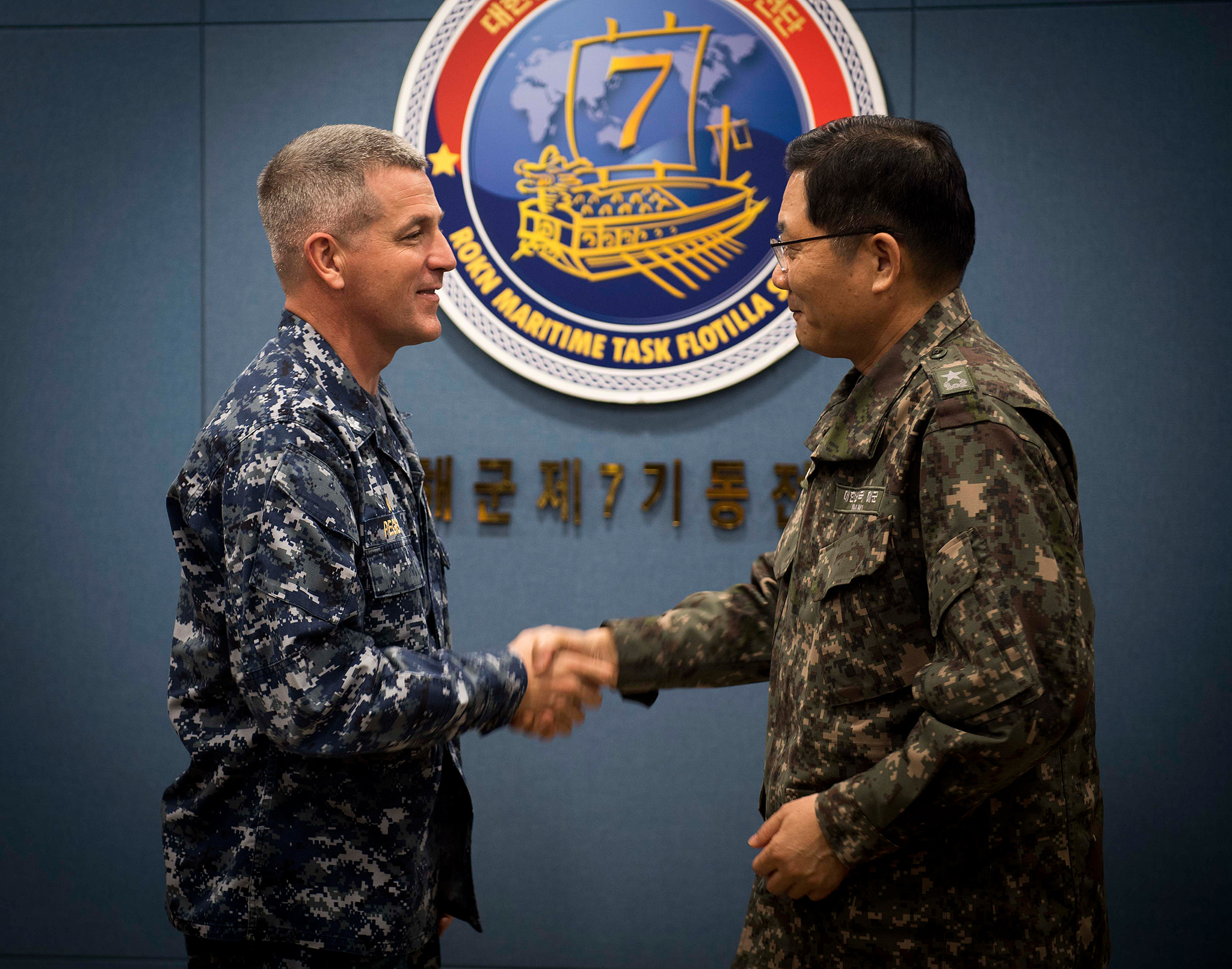
Another consideration is when to employ less technologically advanced forces. Platforms with more rudimentary capabilities can make large contributions, particularly during Phase 0 shaping operations or security cooperation, where much of the effort relies on presence and partnership development. Likewise, they can play significant roles in the later phases of stabilization and enabling of civil authority. However, depending on the threat, less capable forces may be positioned elsewhere during the high intensity phase of an operation. This could be politically problematic, contributing to perceptions of “ally X has no skin in the fight” or “the U.S. doesn’t trust us or consider us to really be a member of the team.” Every effort should be made to give credit where it is due and highlight the importance of the diverse contributions made by multinational forces in supporting the overall effort.
Interoperability in a particular task is often constrained by the least technologically proficient participant.32 However, some data can be reformatted to comply with other standards and forwarded to feed less capable systems, such as when forwarding between tactical data links (Link 16 and Link 22 to Link 11).33 Likewise, some attributes can be stripped from data to make information releasable to partners by using systems like Radiant Mercury.34 Technology like this will be increasingly critical going forward.
Conclusion
America’s technological lead is perishable and due to the global connectivity afforded by the internet, advances are proliferating at an incredible rate. Unmanned aerial vehicles like quadcopters were science fiction a few years ago, but can now be purchased commercial off-the-shelf (COTS) at Walmart and flown with a smart phone. Satellite-based imagery, encryption software, secure communication gear, and navigation systems are widely available to anyone, including adversaries. The science and technology gap remains a strategic imperative that the U.S. must focus efforts to maintain. However, in the face of increasingly capable and assertive adversaries, the U.S. must use every available avenue to mitigate the gap to ensure interoperability with allies and partners.
Tim McGeehan is a member of the Navy’s Information Warfare Community. He has previously served in S&T positions and as an exchange officer to the UK Royal Navy.
Douglas T. Wahl is the METOC Pillar Lead and a Systems Engineer at Science Applications International Corporation.
The ideas presented here are those of the authors alone and do not reflect the views of the Department of the Navy or Department of Defense.
References
1. National Air and Space Museum, The Tizard Mission – 75 Years of Anglo-American Technical Alliance, November 17, 2015, http://blog.nasm.si.edu/aviation/the-tizard-mission/
12
2. Ernest Volkman, Science Goes to War, p. 158
3. National Air and Space Museum, “Buzz Bomb”: 70th Anniversary of the V-1 Campaign, June 13, 2014, http://blog.nasm.si.edu/history/buzz-bomb-70th-anniversary-of-the-v-1-campaign/; Annie Jacobsen, Remembering ‘Operation Paperclip,’ when national security trumped ethical concern, PBS Newshour, March 31, 2014, http://www.pbs.org/newshour/bb/operation-paperclip-national-security-trumped-ethical-concern/
4. Marshall Space Flight Center History Office, Bio: Dr. Wernher von Braun, 2015, http://history.msfc.nasa.gov/vonbraun/bio.html
5. Nikki Ficken, US, UK arrangement allows joint research, AMRDEC Public Affairs, February 23, 2017, https://www.army.mil/article/183095/us_uk_arrangement_allows_joint_research; Megan Eckstein, U.S., Sweden Sign Agreement To Collaborate On Anti-Sub, Anti-Air R&D, Exercises, USNI News, June 8, 2016, https://news.usni.org/2016/06/08/sweden_us_agreement
6. https://www.ida.org/~/media/Corporate/Files/Publications/STPIPubs/ida-d-3306.ashx
7. http://www.presidency.ucsb.edu/ws/?pid=11211
8. Ernest Volkman, Science Goes to War, p. 208; http://www.dollartimes.com/inflation/inflation.php?amount=1&year=1958
9. Ernest Volkman, Science Goes to War, p. 208
10. Bob Work, The Third U.S. Offset Strategy and its Implications for Partners and Allies, January 28, 2015, http://www.defense.gov/News/Speeches/Speech-View/Article/606641/the-third-us-offset-strategy-and-its-implications-for-partners-and-allies
11. Hagel, Chuck, “Defense Innovation Days: Keynote Speech” September 3, 2014, http://www.defense.gov/Speeches/Speech.aspx?SpeechID=1877
12. Hagel, Chuck, “Defense Innovation Days: Keynote Speech” September 3, 2014, http://www.defense.gov/Speeches/Speech.aspx?SpeechID=1877
13. Hagel, Chuck, “Defense Innovation Days: Keynote Speech” September 3, 2014, http://www.defense.gov/Speeches/Speech.aspx?SpeechID=1877.
14. Jonathan Greenert and James Foggo, Forging a Global Network of Navies, USNI Proceedings, May 2014, http://www.usni.org/magazines/proceedings/2014-05/forging-global-network-navies
15. Dan Lamothe, What happens when the most advanced fighter jets in the U.S., France, and Britain prepare for war, The Washington Post, December 17, 2015, https://www.washingtonpost.com/news/checkpoint/wp/2015/12/17/what-happens-when-the-most-advanced-fighter-jets-in-the-u-s-france-and-britain-prepare-for-war/
16. Pierre Nolin, Interoperability: The Need for Transatlantic Harmonization, NATO Parliamentary Assembly Annual Meeting, 2006, http://www.nato-pa.int/default.asp?SHORTCUT=1004
17. Joint Publication 3-16: Multinational Operations, July 16, 2013, http://www.dtic.mil/doctrine/new_pubs/jp3_16.pdf
18. Megan Eckstein, U.S., Japanese Destroyers Conduct First-Of-Kind Parts Swaps During Interoperability Exercise, USNI News, March 17, 2017, https://news.usni.org/2017/03/17/u-s-japanese-destroyers-conduct-first-ever-parts-swaps
19. Michele Zanini and Jennifer Taw, The Army and Multinational Force Compatibility, Rand Report 2000, http://www.dtic.mil/cgi-bin/GetTRDoc?Location=U2&doc=GetTRDoc.pdf&AD=ADA383687, p. 22
20. Michele Zanini and Jennifer Taw, The Army and Multinational Force Compatibility, Rand Report 2000, http://www.dtic.mil/cgi-bin/GetTRDoc?Location=U2&doc=GetTRDoc.pdf&AD=ADA383687, p. 22
21. Joint Publication 3-16: Multinational Operations, July 16, 2013, http://www.dtic.mil/doctrine/new_pubs/jp3_16.pdf , p. xv
22. Michele Zanini and Jennifer Taw, The Army and Multinational Force Compatibility, Rand Report 2000, http://www.dtic.mil/cgi-bin/GetTRDoc?Location=U2&doc=GetTRDoc.pdf&AD=ADA383687, p. 52
23. Robert Burns, Pentagon Chief Carter: Europe ‘Not Doing Enough’ On Defense, Associated Press, April 22, 2015, http://hosted.ap.org/dynamic/stories/U/US_CARTER_EUROPEAN_DEFENSE
24. Stephen Fidler, NATO Leaders Vow to Lift Military Spending, The Wall Street Journal, September 4, 2014, http://www.wsj.com/articles/nato-leaders-to-vow-to-lift-military-spending-1409832341
13
25. Luke Meineke, Aegis Ashore Missile Defense System Team Arrives at NSF Deveselu, June 6, 2015, http://www.navy.mil/submit/display.asp?story_id=87534
26. BBC News, Russia Mistral: France halts delivery indefinitely, November 25, 2014, http://www.bbc.com/news/world-europe-30190069
27. Mark Landler and Thom Shanker, U.S., in Sign of Displeasure, Halts F-16 Delivery to Egypt, July 24, 2013, http://www.nytimes.com/2013/07/25/world/middleeast/us-halts-delivery-of-f-16-fighters-to-egypt-in-sign-of-disapproval.html?_r=0
28. Ernesto Londono, U.S. halts delivery of F-16s to Egypt, Washington Post, July 24, 2013, https://www.washingtonpost.com/world/national-security/us-halts-delivery-of-f-16s-to-egypt/2013/07/24/f227ac7a-f495-11e2-aa2e-4088616498b4_story.html
29. Rachel Stohl, Shannon Dick, and Axelle Klincke, US Military Assistance To Thailand, May 28, 2014, http://www.stimson.org/spotlight/us-military-assistance-to-thailand-/
30. Tomkins, Richard, US Navy authorizes building of Common Missile Compartment Tubes, UPI, October 31, 2014, http://www.upi.com/Business_News/Security-Industry/2014/10/31/US-Navy-authorizes-building-of-Common-Missile-Compartment-tubes/8481414785104/
31. The Gryfs of Europe: Europe is starting to get serious about defence, The Economist, 23 February 2017, http://www.economist.com/news/europe/21717391-under-pressure-donald-trump-herbivores-are-thinking-about-eating-meat-europe-starting
32. Joint Publication 3-16: Multinational Operations, July 16, 2013, http://www.dtic.mil/doctrine/new_pubs/jp3_16.pdf , p. III-21
33. Northrup Grumman, Understanding Voice and Data Link Networking, December 2014, http://www.northropgrumman.com/Capabilities/DataLinkProcessingAndManagement/Documents/Understanding_Voice+Data_Link_Networking.pdf
34. Barry Rosenberg, Addressing security challenges of a common operating environment, Defense Systems, June 11, 2013, https://defensesystems.com/articles/2013/04/26/one-on-one-quinn.aspx
Featured Image: POHANG, Republic of Korea (April 7, 2017) – Staff Sgt. Robin McClain a cyber-technician assigned to the 621st Contingency Response Wing stationed at Joint Base McGuire-Dix-Lakehurst, N.J., shares knowledge with two Republic of Korea Airmen during exercise Turbo Distribution 17-3 at Pohang Air Base, Republic of Korea, April 7, 2017. (U.S. Air Force photo by Tech. Sgt. Gustavo Gonzalez/Released)

